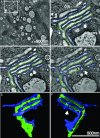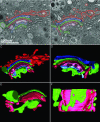Direct continuities between cisternae at different levels of the Golgi complex in glucose-stimulated mouse islet beta cells
- PMID: 15064406
- PMCID: PMC397423
- DOI: 10.1073/pnas.0401242101
Direct continuities between cisternae at different levels of the Golgi complex in glucose-stimulated mouse islet beta cells
Abstract
Direct continuity between the membranes of cisternae in the Golgi complex in mammalian cells rarely has been observed; when seen, its documentation has been equivocal. Here we have used dual-axis electron microscope tomography to examine the architecture of the Golgi in three dimensions at approximately 6-nm resolution in rapidly frozen, freeze-substituted murine cells that make and secrete insulin in response to glucose challenge. Our data show three types of direct connections between Golgi cisternae that are normally distinct from one another. These connections all "bypass" interceding cisternae. We propose that when pancreatic beta cells are stimulated to synthesize and secrete insulin rapidly in vivo, such connections provide a continuous lumen that facilitates the rapid transit of large amounts of newly made protein for secretion. The heterotypic fusion of cisternae, even transiently, raises important questions about the molecular mechanisms that (i) facilitate the fusion/fission of cisternal membranes and control the directionality and specificity of such events, and (ii) retain Golgi processing enzymes at specific places within individual cisternae when two cisternae at different levels in the Golgi have fused, maintaining the sequential processing hierarchy that is a hallmark of Golgi organization.
Figures



References
-
- Rothman, J. E. (1994) Nature 372, 55–63. - PubMed
-
- Grassé, P. P. (1957) C. R. Acad. Sci. 245, 1278–1281. - PubMed
-
- Bonfanti, L., Mironov, A. A., Jr., Martinez-Menarguez, J. A., Martella, O., Fusella, A., Baldassarre, M., Buccione, R., Geuze, H. J., Mironov, A. A. & Luini, A. (1998) Cell 95, 993–1003. - PubMed
Publication types
MeSH terms
Substances
Grants and funding
LinkOut - more resources
Full Text Sources

